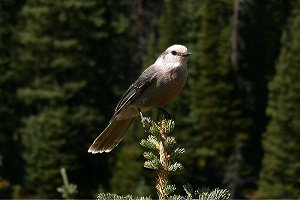|
Sunday, September 18th - Photo Of The Week... This week's photo features one of the high country's permanent residents, the "Gray Jay". The Gray Jay, Perisoreus canadensis, can be found in coniferous and coniferous-deciduous forests. It is most frequently found in spruce and fir forests. It is very rarely seen outside of its forest environment. The gray jay mates in the spring. The male
chooses a nest site, usually in a conifer tree like the spruce
or fir and then he begins building the nest. The bowl-shaped
nest is made of twigs, grass, lichen, moss and bark fastened
together with spider webs and insect cocoons. The nest is lined
with grass, moss, fur and feathers. The female will help build
the nest. It can take up to three weeks for the pair to complete
the nest. The gray jay eats fruits, seeds and insects. In winter, a large part of its diet is made up of conifer seeds. It uses its saliva to roll seeds together and then stores the seed balls to eat later. The gray jay is also known as the "camp robber." It is very tame and it often enters camps to take food. |
